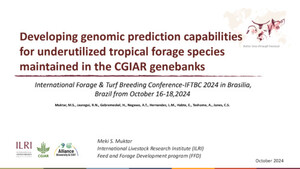
Increasing smallholder pig farmers' adaptive capacity: Low-cost balanced diets for East African pigs using livestock and plant co-products
Abstract
By acquiring livestock poor farmers can ascend out of poverty. Pigs require minimal inputs
and raising them is often within disadvantaged members of society’s means. In East Africa,
2.2 million pigs are raised by resource-poor, subsistence farmers most with under 2 hectares of
cropland. They typically raise 1–4 pigs to pay for school, medical costs, food, and seeds, but
pig productivity is low. Lack of feed, seasonal feed shortages and unbalanced diets contribute
to slow growth, resulting in compromised earnings from pig-raising.
We estimated East African pig feedstuff nutrient composition through nutrient analysis and
from literature. Seasonal availability was identified by local experts. Performance results from
local-breed pig feeding trials were used to adjust the NRC (2012) nutrient requirement model
for growing-finishing pigs. Local pigs’ nutrient requirements under typical management conditions
(intestinal parasites present and free-ranging) were estimated. A least-cost diet formulation
programme was used to generate diets minimising cost and human/pig competition
for food, maximising agricultural co-products and forages use, considering seasonal availability,
and satisfying minimal requirements for digestible energy 2960 kcal per kg of dry matter
[DM]), calcium, standardised total tract digestible phosphorous, standardised ileal digestible
crude protein and lysine (0.28, 0.13, 8.5, and 0.58% of DM respectively)
Feedstuffs availability differed between November-February; June-August; and March-May
plus September-October. Estimated growth performance potential of local pigs is less when
free-ranging, or intestinal parasite infected, than when restrained and non-infected (80; 217;
and 259 g per day respectively) A typical least-cost diet for June-August (all as % of DM) is:
maize flour 20.6; cassava leaf 20.0; sweet potato vine 19.2; ripe avocado 15.0; Bidens pilosa
7.9; limestone 7.7; molasses 5.0; cattle blood 3.9; Amaranthus spinosus 0.3; table salt 0.24;
premix 0.10. Sun-dried fish (Rastrineobola argentea) and grist mill waste are available all year
as substitutes for seasonably available ingredients e.g avocado and sweet potato vine.
Use of such diets will enable continuous pig feeding during all seasons, thereby increasing
farmer resilience. Their use will improve pig performance resulting in increased farmer income,
enabling poverty alleviation, improved food security, human health and nutrition, and
investment in other livelihood ventures to further increase resilience.
Citation
Carter, N., Dewey, C., Grace, D., Lukuyu, B. and Lange, C.F.M. de. 2015. Increasing smallholder pig farmers' adaptive capacity: Low-cost balanced diets for East African pigs using livestock and plant co-products. Presented at the Tropentag 2015, Berlin, Germany, 16-18 September 2015. Nairobi, Kenya: ILRI.









